
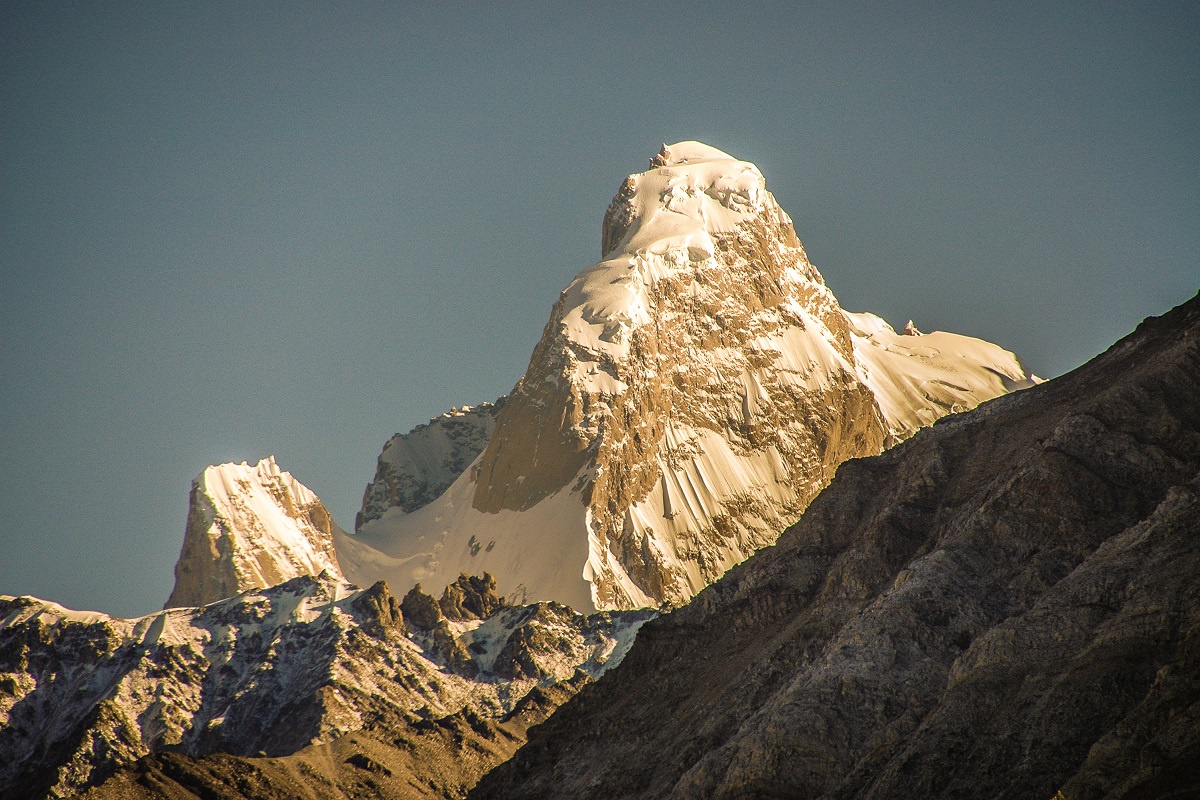
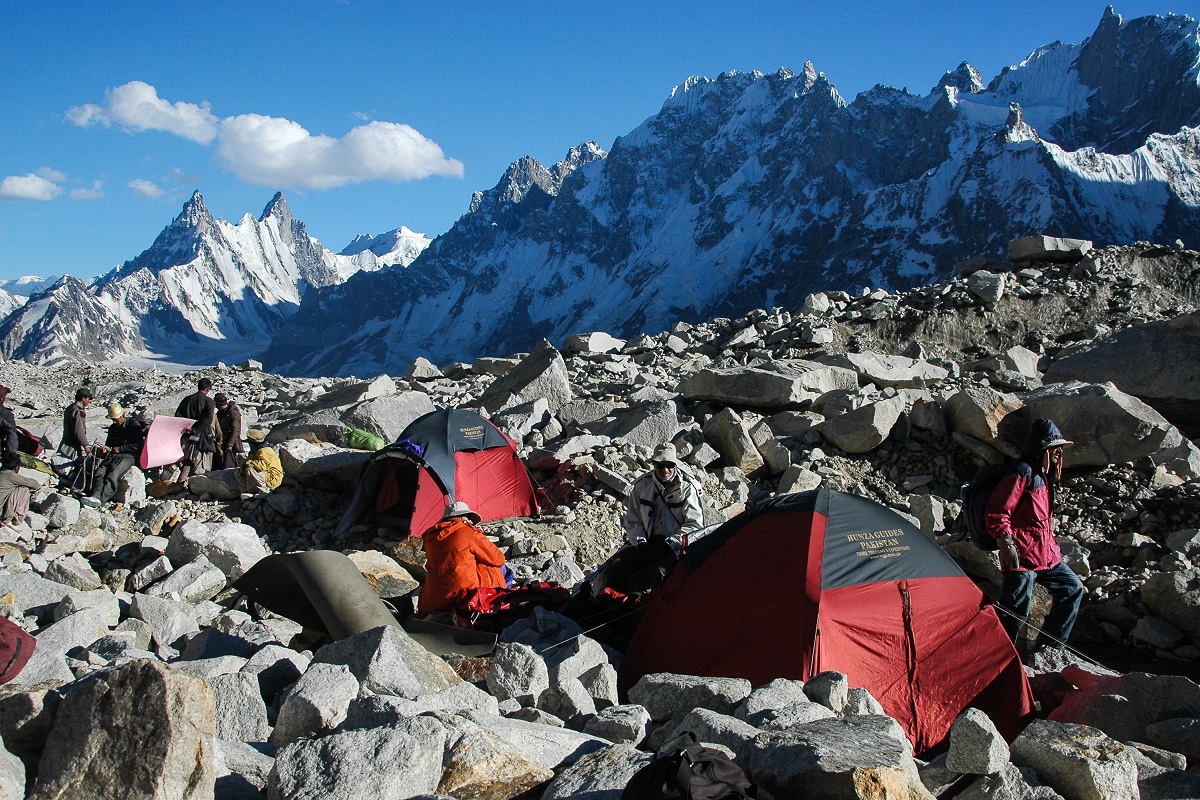
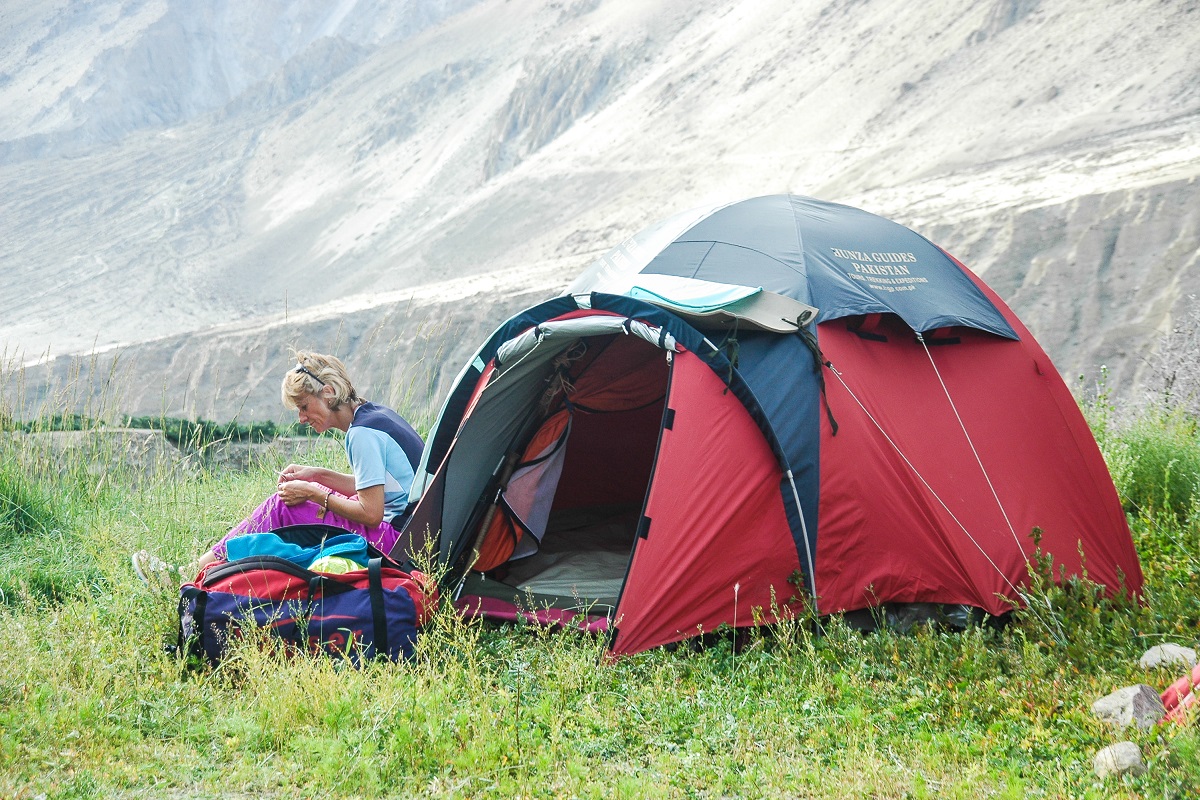

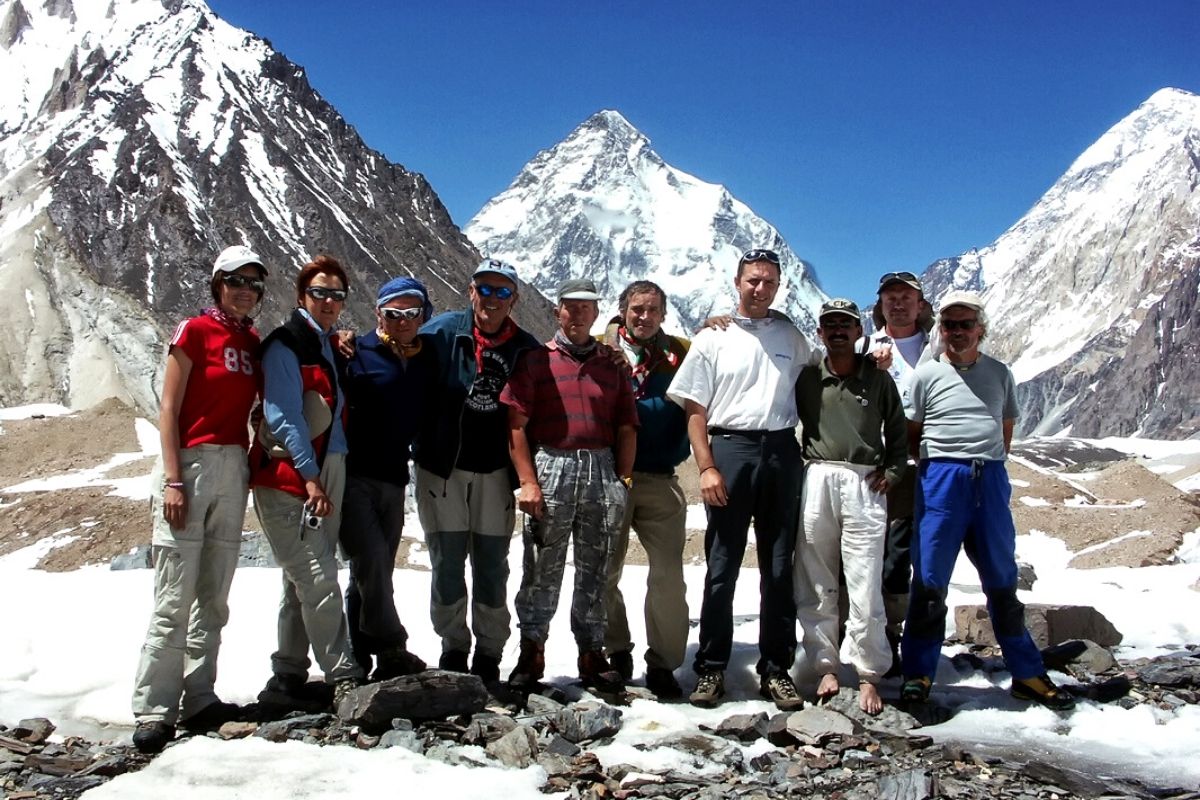
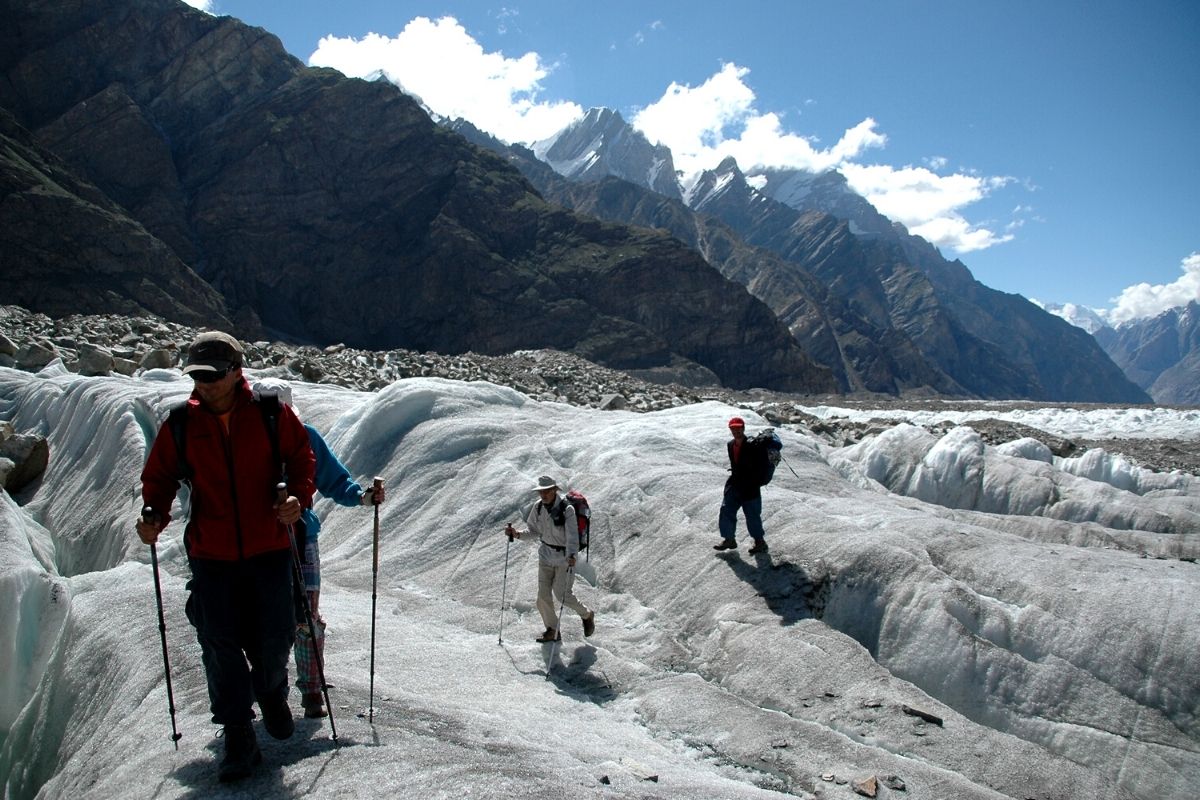

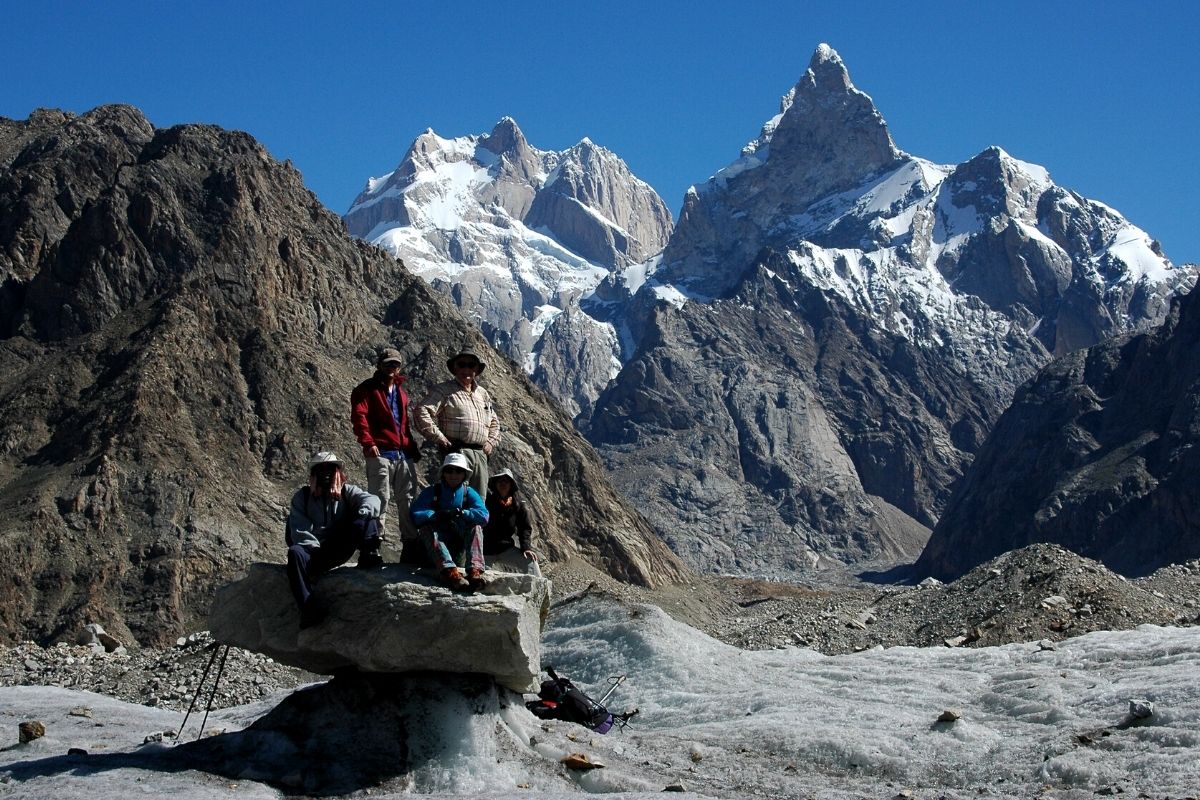
Great Karakoram Traverse Trek
The Great Karakoram Traverse is one of the longest and highest walking trails in the world. Winding beneath the world’s highest peaks and visiting some of the most remote communities on earth, it passes through lush green valleys, arid high plateaus and incredible landscapes.
The trail covers almost the full distance of the Karakorum Range in Pakistan from the Skardu to Khaplu valley and ultimately continues through Baltoro, Biafo and Hispar Glaciers to Hunza and Gilgit.
The Karakoram great traverse 32 days trek begins from the beautiful Hushe valley, gateway to Mashaburm 7821m, Charakusa peaks. The thrilling half day jeep journey leads you to the heart of the peaceful Hushe valley from Skardu. From Hushe you begin the adventurous trek into the great Karakorum wilderness and will not see another village for another thirty days.
A Karakoram great traverse combination of days trek through Hushe valley leads you to Gondogoro La and after crossing it to the great Baltoro glacier with the most remarkable mountain vistas in the world. After a visit to the base camp of K-2 (the second highest in the world at 8611 meter) we return to Concordia and proceed to Biafo Glacier and Hisper La. This pass leads you into the beautiful Hopper valley Nagar and further to Hunza.
- The crossing of Hisper La 5151 m
- Hisper Pass is one of the longest glacial systems outside the polar regions.
- This highway of ice connects two ancient mountain kingdoms; Hunza in west with Baltistan in the east
- Walking on Biafo and Hisper Glacier
- One of the world`s top 5 trekking adventures
- Trek up to Biafo Glacier (Longest and world’s largest outside the polar region)
- Views of peaks between 5,000 m to 7,000 m Peaks
Welcome at Islamabad airport, and transfer to hotel.
Afternoon proceed for city tour of Islamabad and Rawalpindi, which includes famous Faisal Mosque, Shakar Parian, Pakistan monument, Damen Koh, Lok Versa, Museum, Rawalpindi old bazaar, Raja Bazaar.
Altitude: 540 M
Accommodation: Hotel
Meals: Breakfast, Lunch, Dinner
Today we take the short but spectacular flight to Skardu one hour. Afternoon is free to explore Skardu town.
Note: If our flight is cancelled due to bad weather, we will start the drive to Chilas via Babusar Pass 4,173 m, 461 km.
• Altitude: 2,228 M
• Accommodation: Hotel
• Meals: Breakfast, Lunch, Dinner
Free/preparation day in Skardu. Today we enjoy a free day in Skardu where we can visit the Bazaar and Khurpucho Fort.
Note: If our flight canceled on day 2, we will spend 8-9 hours driving from Chilas to Skardu along with Indus River.
• Altitude: 2,228 M
• Accommodation: Hotel
• Meals: Breakfast, Lunch, Dinner
Drive to Hushe by jeeps via 6-7 hours 120 km.
Hushe is starting point of our trek. It is a spectacular drive from Skardu to Hushe. The jeep road crosses the Shyok River and passes the villages of Khaplu, Macholo, Kanday and Khaney.
• Altitude: 3,050 M
• Accommodation: Camping
• Meals: Breakfast, Lunch, Dinner
Trek from Hushe Village to Shaico 4-5 hours, 9.3 km.
• Altitude: 3,300 M
• Accommodation: Camping
• Meals: Breakfast, Lunch, Dinner
Trek to Gondogoro camp 3-4 hours, 3.9 km, 620 ascents.
• Accommodation: Camping
• Meals: Breakfast, Lunch, Dinner
Trek from Gondogoro camp to Hispung 5-6 hours.
• Altitude: 4,680 M
• Accommodation: Camping
• Meals: Breakfast, Lunch, Dinner
Trek to Ali camp 9-10 hours after crossing Gondogoro La 5650 m.
from base of Pass we climb up to the pass 45 to 50 degrees’ ascent to the summit of the with fix rope and wearing crampons. The view from the pass is exciting and superb of K2 and all the 8000 meters. The views from the pass including K2, Board Peak, Gasherbrum I to IV are unparalleled, making all the hard work worthwhile. After crossing the pass, we descend to Ali Camp.
• Altitude: 5,010 M
• Accommodation: Camping
• Meals: Breakfast, Lunch, Dinner
Trek to Concordia 5-6 hours.
Where the Baltoro, Abruzzi and Godwin Austen glaciers meet. The 360-degree panoramic view here is one of the most spectacular sights in the world. Concordia the joining of the five glaciers you will be in the heart great Mountain K2, 8611 m, Broad Peak 8047 m, Angel Peak 6858 m to the left and to the East Baltoro Kangri, Kondus, Snow Dome, Golden Throne and numerous nameless mountains all around this is an exciting day of your trip.
• Altitude: 4,650 M
• Accommodation: Camping
• Meals: Breakfast, Lunch, Dinner
Trek to Broad Peak Base camp 4,800 m which offers one of the best views of K2. Afterwards we continue on to K2 Base Camp 5,135 m and then return to Concordia for the night.
• Altitude: 4,650 M
• Accommodation: Camping
• Meals: Breakfast, Lunch, Dinner
Trek to Goro-II, 4-5 hours 9.2 km.
Have a nice views of Masherbrum 7821 m, Muztagh Tower 7,284 m and Biarchedi Peak 6,781 m.
• Altitude: 4,380 M
• Accommodation: Camping
• Meals: Breakfast, Lunch, Dinner
Trek to Urdukas 5-6 hours, 330 m decent, 12.1 km.
View of Paiyu Peak 6,610 m, Uli Biaho 6,417 m, Great Trango Tower 6,286 m, Lobsang Spire 5,707 m and the Cathedral Towers.
• Altitude: 4,050 M
• Accommodation: Camping
• Meals: Breakfast, Lunch, Dinner
Trek to Paiyu 5-6 hours, 15.9 km, views of Cathedral and Trango Towers and Uli Biaho.
• Altitude: 3,450 M
• Accommodation: Camping
• Meals: Breakfast, Lunch, Dinner
Trek to Jhola 6-7-hours, 150 m decent, 16.6 km. Enjoy great views of Bakhor Das 5,809 m and Dumurdo River.
• Altitude: 3,200 M
• Accommodation: Camping
• Meals: Breakfast, Lunch, Dinner
rek to Korofong 3-4 hours, 7.4 km, 150 decent.
• Altitude: 3,200 M
• Accommodation: Camping
• Meals: Breakfast, Lunch, Dinner
Trek from Askoli village to Namla 6-7 hours.
The early morning light finds us beginning our Snow Lake and Biafo Hisper trek as the Loads are distributed among the porters. Walks through Askoli 3000 m and past the confluence of the Biafo and Biafo rivers, following the true right bank of the Biafo River to Kisar Shaguran, beyond which the trails to the Biafo Glacier divide, the Biafo turn to the northeast and the Baltoro continues east. Move onto the moraine-covered Biafo glacier. Have a nice view of Pyramidal Baakhor Das Peak.
• Altitude: 3,400 M
• Accommodation: Camping
• Meals: Breakfast, Lunch, Dinner
Trek to Shikonfon 4-5 hours 6.7 km.
Cross the crevassed area to the highest ridge on the glacier. Ahead to the top north are the 3 visible Latok Mountains. Latok -1 (7145 m), Latok -II (7108 m) and Latok -III (6949 m). Climb gently for a couple of hours, on the unstable boulders all the way, then angle in across the crevasses to Mango, an ablation valley with grass and willows bushes by side stream flowing from the striated snow ridge and glacier of 5, 355m Mango Brakk.
• Altitude: 3,660 M
• Accommodation: Camping
• Meals: Breakfast, Lunch, Dinner
Trek to Baintha 6-7 hours 10.7 km.
This is lovely, the easy day starting with a short walk along the ablation valley past a small lake, then heading out across the lateral crevasses to the smooth, white center of the Biafo glacier. Ahead is your first view of the Hisper Pass. The mountain walls on either side rise to 6000 m, the serrated rock. Here we cross two medial moraines and climb the lateral moraine to find a green ablation valley and follow it up to Biantha, a grassy area with a clear stream following through dense willows shrubs surrounded by flowers the greenery and flowing water we can see for five days.
• Altitude: 3,990 M
• Accommodation: Camping
• Meals: Breakfast, Lunch, Dinner
Free day for local exploration and porters will prepare their food for further Snow Lake trek. We enjoy a slow start today taking in our stunning surroundings. We take a short acclimatization trek during the day and in the evening sing and dance with the porters.
• Altitude: 3,990 M
• Accommodation: Camping
• Meals: Breakfast, Lunch, Dinner
Trek to Marpogoro 5-6 hours.
Start with 45 minutes of easy walking up the ablation valley past several small lakes surrounded by flowers and willow bushes (can see bear droppings and ravens) followed by 30 minutes of crossing difficult crevasses out to the easy white ice. Please do not get too close to the Biantha Lukpar glacier, as the ice is churned up where the two glaciers meet. The next few hours are an easy stroll up smooth ice, stepping over frequent small crevasses. If the glacier is snow covered, we must rope up and walk in single file all the way across the pass. The Biafo is hemmed in by gleaning glaciers on the south and jagged granite on the north. Napina is green campsite in the northern ablation valley, with fresh water but no bushes if you don’t wish to detour into Napina, we can camp out on the ice in the middle of Biafo at about 4400m and porters will collect water from glacier melt. Walk up the ice highway, until apposite the first of the three rock camps named for the color of the rock above them.
• Altitude: 4,410 M
• Accommodation: Camping
• Meals: (Breakfast, Lunch, Dinner)
Trek from Marfogoro to Karpogoro 5-6 hours
• Altitude: 4,680 M
• Accommodation: Camping
• Meals: Breakfast, Lunch, Dinner
Trek to Snow Lake Hisper La base camp 6-7 hours 11.6 km. Altitude 4770 m.
This is ready poled on snow-covered ice (rope essential, gaiters recommended), zigzagging to cross the crevasses but keeping slightly right of center. Wagtails and Ravens follow you up. Snowy peaks adrip with glaciers wall you in on the south, as do granite towers on the north. At the intersection with the Sim Gang glacier and Snow Lake (Lukpe Lawo), the route to the Hisper Pass leads off the west. The ice here is about 1.5 kilometers thick and flowing at about 300m a year. Camp at about 4780min a flat bowl of ice several kilometers wide and surrounded by jagged black and white mountains. (From here treks leads north across Snow Lake and Khurdopin pass 5790 to the Shimshal valley)
• Altitude: 4,770 M
• Accommodation: Camping
• Meals: Breakfast, Lunch, Dinner
Trek to Hisper La 4-6 hours, 4.2 km.
This day we recommend Rope, gaiters and waterproof boots are essential. It is an easy, steady climb to the top of the Hisper pass 5151 m but quite strenuous at this altitude. The route wends gently up the center, with giant crevasses and stripped greenish- blue seracs on either side. Looking back across Snow Lake gives a feeling of vast snowy space, without a hint of vegetation. Coiling out from Snow Lakes, smooth glaciers writhe between nameless unclimbed peaks..
• Altitude: 5,151 M
• Accommodation: Camping
• Meals: Breakfast, Lunch, Dinner
Trek to Khani Bassa 14 km, 4-5 hours.
3 to 5 hours trek down to Khani Bassa, depending on snow conditions, even in the early morning, the snow can be so soft that we can sink up to our calves. Undulate for one hour cross the top of the Pass, than plod sharply down the center on smooth snow, jumping small crevasses for another hour or so. Beware of hidden crevasses, rope up, and walk in single file. Large crevasses and seracs border the glacier on both sides. To more hours of boulder hopping on scree and moraine leads to a small green campsite just before the junction with the Khani Bassa glacier, have a nice view of the white wall of Balchish range, which is 6000 m.
• Altitude: 4,511 M
• Accommodation: Camping
• Meals: Breakfast, Lunch, Dinner
Trek to Jutmal 4-5 hours.
It takes about 90 minutes to cross the Khani Bassa glacier. It is relatively easy going, with a fine view north to the smooth white dome of Kanjut SAR at 7,760m the 29th highest peak in the world. There are plenty of places for camping between Khani Bassa and Yutmaru glaciers. Much of the way is along a clear path high on the lateral moraine above 30 m of the glacier, with magnificent views across to the hanging glaciers and frequent avalanches on the southern ice wall. Camp about an hour before the Yutmaru glacier in a flat, sheltered field in the ablation valley, which offers rooms for many tents, here is running water until mid-August. A few small willow bushes and flowers are around the site.
• Altitude: 4,380 M
• Accommodation: Camping
• Meals: Breakfast, Lunch, Dinner
Trek to Red Star 6-7 hours.
The Yutmaru glacier takes at least 2 hours to cross, with high ice walls and deep crevasses to negotiate. On the other side climb steeply up under the cliff to a good possible campsite with a panoramic view back to the Hisper pass (but on the water in September). We will have to cross few screes, and there is a shortage of water, but flowers and fine views make this otherwise idyllic. There are at least 5 possible campsites along the way. The lower path, following the edge of the glacier, is more difficult and not as scenic.
• Altitude: 4,150 M
• Accommodation: Camping
• Meals: Breakfast, Lunch, Dinner
Trek to Bitanmal 5-6 hours 7.9 km.
Cross a stream from the small tributary glacier just beyond camp and descend steeply to the ablation valley along the Hispar Glacier, north margin. Move onto boulder covered medial moraine 30 minutes from the cam. On either side of this level moraine are heavily broken sections. Although a trail hugs the grassy hillside above the glacier.
• Altitude: 2,228 M
• Accommodation: Hotel
• Meals: Breakfast, Lunch, Dinner
Trek to Hisper village 4-5 hours.
Trek through a green trail to the pastures of Bitanaml beneath lofty Makrong Chhish 6607m descend steep talus to the edge of the Kunyang Glacier and cross it on a faint trail. Stroll down the ablation valley. Cross the Hisper river bridge and climb to Hisper village.
• Altitude: 3383 M
• Accommodation: Hotel
• Meals: Breakfast, Lunch, Dinner
Drive to Karimabad (Hunza Valley) by 4X4 Jeeps.
• Altitude: 2,500 M
• Accommodation: Hotel
• Meals: Breakfast, Lunch, Dinner
Drive to Chilas 240 KM, after lunch continue drive to Naran 3-4 hours 113 km via Babusar Pass 4173 m.
• Altitude: 2,409 M
• Accommodation: Hotel
• Meals: Breakfast, Lunch, Dinner
Drive from Naran to Islamabad 239 km 6-7 hours.
• Altitude: 540 M
• Accommodation: Hotel
• Meals: Breakfast, Lunch, Dinner
Transfer to Islamabad airport for international flight
- All domestic flights and road transfers
- All hotel accommodation (twin sharing room)
- All trekking accommodation
- All camping site and bridge fees
- All trekking logistics (all tents, non-personal equipment and tools etc)
- All meals (breakfast, lunch and dinner)
- Licensed professional guide (government requirement)
- Government trekking permit fees and paperwork
- Waste management fees (government requirement)
- Support staff (cook, assistant(s) etc)
- Porter for personal luggage (15 kgs)
- First aid medicine kit (basic)
- Satellite phone for emergencies
- D3V sleeping tent, Toilet Tent, Shower Tent.
- International airfare and airport taxes.
- Visa fee for Pakistan and personal insurance of the clients.
- Tips for drivers, porters and staff
- Single Supplement
- Transfers to and from airports for participants making individual air arrangements
- Optional excursions or deviations from the scheduled tour
- Sleeping bag and all personal expenses such as telephone charges, liquor or soft drinks,
- Room service, gratuities for personal services, items of a purely
- Any other service that is not mentioned in the list above.
